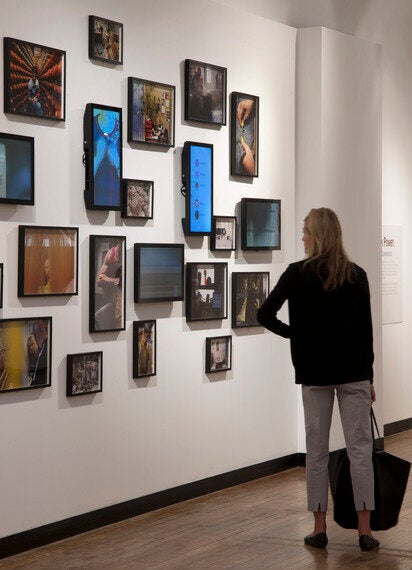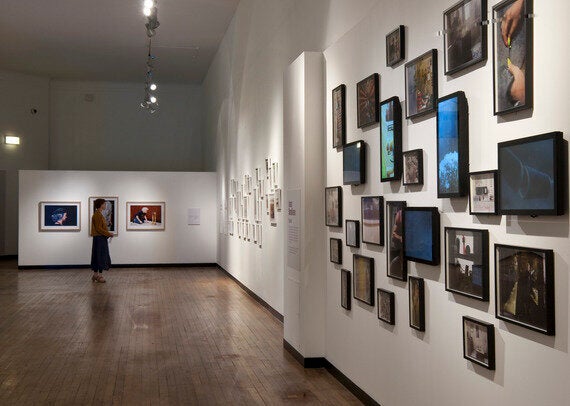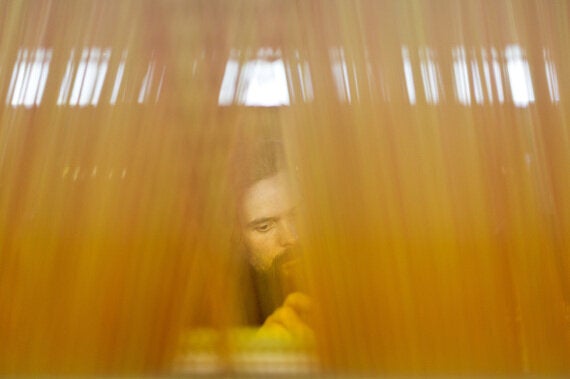
In 2013, Magnum Photos and Multistory commissioned nine photographers to capture the state and spirit of British manufacturing - its variety, its people and its processes.
Given the difficult economic conditions, that was quite a challenge. Yet the resulting exhibtion, Open for Business, is a fascinating insight into an industry that is surviving, even thriving, against quite extraordinary odds.
What immediately catches the eye is Stuart Franklin's stunning photos of manufacturing in Scotland. With an interest in the relationship between man and his environment, Stuart focused on the renewable energy companies - wind and wave - and the construction of the HMS Queen Elizabeth, the largest aircraft carrier in the Royal Navy's history.
His scale and dynamism in his work is impressive. A particular favourite for me was a powerful photo of the harnessing of wave power by the Pelamis Wave machines.
In contrast, David Hurn focused on small-scale bespoke textile and crafts industry in Wales. His series of colourful images capture the human element, the dependency on minute manually intensive work and the bespoke results it can bring.

Being Welsh himself, David's photos played cleverly against the stereotype of Welsh industry as solely that of the (declining) coal mines. It also emphasised that where Britain cannot compete against the cheap mass production factories of the Far East, it can flourish if it focuses and invests in skilled labour.
A particular highlight was a selection of socks that Prince Charles had designed, taking into account regimental colours and designs, which were being woven by royal-appointed hosiery specialists Corgi Hosiery.
I had expected the photographs to be depressing, to reflect a sector in decline and a workforce shrinking in numbers and very much cogs in a wheel. Certainly that does come through in some pieces.
Peter Marlow's photography of metal and leather industries in the Black Country showed a hazardous workplace where dangerous and centuries old methods such as furnaces for smelting were still in use.
And through his portraits of the workforce, you could see the physical impact of decades of labour in these places. They were quite moving.

Similarly, there's plenty of drama in Mark Power's photos of the Nissan factory in Sunderland and Bombardier in Derby. A heavy black background gives his work a powerful feel yet it also lends his work a darkness.
Often the faces of the workforce in these pieces cannot be seen, giving them a functional appearance. And those faces that can be seen are often expressionless, emotions hard to read.
But plenty of the work on display also shows the creativity of British manufacturing, how it has developed and adapted to stay alive and stay competitive.
Chris Steele-Perkins focused on Plymouth, where firms such as Princess Yachts and Burt's Crisps had developed their profile in niche markets. These photos were bright and positive, with the employees almost playful.
And Jonas Bendiksen included VT loops of weaving machines amongst his photography of the textile industry in Bradford. There's both a happy rhythm and a depressing repetition in watching these machines constantly repeating the same process again and again.
Credit must also go to the Science Museum who has made an effort in the presentation. It would have been easy to just frame these photos up and hang them on the wall. Instead these have been collated in clusters, allowing you to immerse yourself in each region, as well as compare and contrast between them.

The intention was always for this to be a travelling exhibition, rather than have it rooted solely in London. So, after the Science Museum, it will travel to the University of South Wales, Newport; the Plymouth City Museum & Art gallery; Mshed, Bristol; and Street Level Photoworks, Glasgow.
Along with this display, the Science Museum is also hosting exhibitions on the history of mental illness treatment, the scientist James Lovelock and the work of controversial photographer Joan Fontcuberta. And that's alongside the Museum's expansive and impressive permanent collection so there is much to see on a visit.
But what you take away from this exhibition in particular is though the struggles remain, the adaptability and creativity within the British manufacturing industry deserves to be celebrated.
Science Museum, London to November 2, 2014
Admission Free
Image credits:
1. Stuart Franklin UK, Scotland. Renewable energy. The Sound of Hoy in the Orkney Islands generates some of the biggest waves in the UK. This wave energy is being harnessed by Pelamis Wave machines. The Old Man of Hoy in the background. 2013
2. Installation image © Science Museum, London
3. Installation image © Science Museum, London
4. Jonas Bendiksen GB, England, Bradford. A worker seen through the criss-crossing threadwork of a weaving machine. William Halstead, weavers of fine mohair and worsteds, operating since 1875. 2013